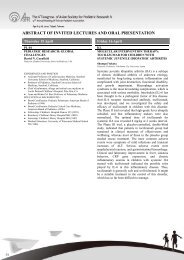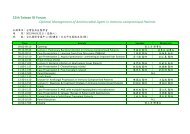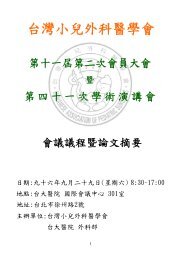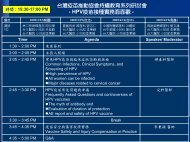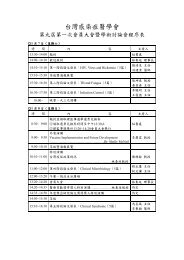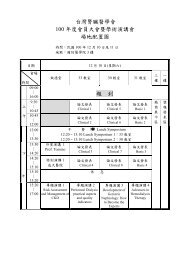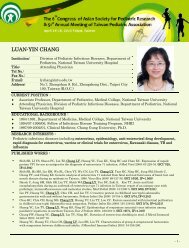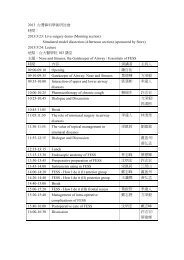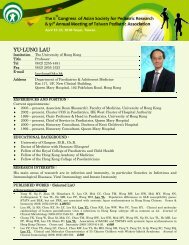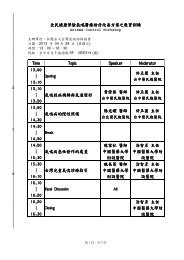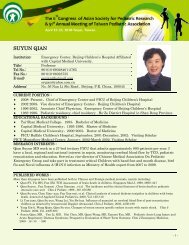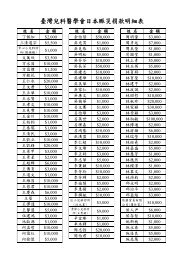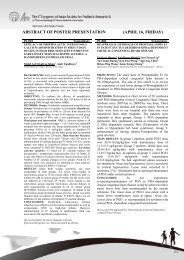ABSTRACT OF POSTER PRESENTATION (APRIL 17, SATURDAY)
ABSTRACT OF POSTER PRESENTATION (APRIL 17, SATURDAY)
ABSTRACT OF POSTER PRESENTATION (APRIL 17, SATURDAY)
Create successful ePaper yourself
Turn your PDF publications into a flip-book with our unique Google optimized e-Paper software.
P2-081 Nephrology P2-082 NephrologyOUTCOME AND RISK FACTORS FORMORTALITY IN PEDIATRIC PERITONEALDIALYSISESTIMATED GLOMERULAR FILTRATIONRATE USING UEMURA FORMULA IS VERIFIEDBY INULIN CLEARANCELing Yu Yang 1 , Jei Wen Chang 2 , Hsin Ln Tsai 3 ,Hsin-Hui Wang 4Pediatric Department, Veterans General Hospital 1 , Department ofPediatrics, Taipei Veterans General Hospital, Taiwan 2 , Division of PediatricSurgery, Department of Surgery, Taipei Veterans General Hospital 3 ,Department of Pediatrics, Section of Nephrology; Department of Pediatrics,Faculty of Medicine, Taipei Veterans General Hospital; NationalYang-Ming University, Taiwan 4BACKGROUND: The mortality rate among childrenrequiring renal replacement therapy is marked higher thanthose among children without end stage renal disease(ESRD). Some factors such as hypoalbuminemia, highperitoneal transport rate, age, malnutrition, cardiovasculardisease and recurrent peritonitis appear to be associatedwith lower survival in adult peritoneal dialysis patients.Data regarding risk factors of mortality in children withcontinuous ambulatory peritoneal dialysis (CAPD) islimited. The aims of the study were to analyze the clinicalcharacteristics of patients and investigate if routinely usedlaboratory and clinical variables are independent riskfactors for mortality in children on CAPD.METHODS: We performed a retrospective chart analysisof pediatric ESRD patients on CAPD between January1997 and September 2008. 29 patients undergoing CAPDfor more than 3 months were enrolled. An analysis wasperformed on clinical and biochemical variables forsurvivors and non-survivors to identify potential riskfactors for mortality.RESULTS: The mean age was 12.18±4.57 years. Duringthe follow- up period, eight patients were transferred tohemodialysis and 13 patients received deceased donorrenal transplantation. At the end of the study, five patientshad died. The actuarial survival rate at 2 and 5 years was96.55% and 91.19%, respectively. The major complicationduring therapy was peritonitis (one episode 57.79 patientmonths). In the univariate analysis, younger age atinitiation of dialysis, the presence of comorbid disease,higher peritoneal transport rate, increased protein lossesthrough peritoneal dialysis, high total daily protein loss,hypoalbuminemia, and hypophosphatemia, were variablesassociated with mortality in pediatric CAPD patients.However, in the multivariate analysis, only low serumalbumin (b=-2.089, p=0.006, Hazard ratio=8.06; 95% CI=0.028, 0.546) was independently associated withmortality.CONCLUSION: Mortality was low in our pediatricpatients receiving CAPD. Hypoalbuminemia showed asignificant association with death in CAPD patients.[Keywords] Hypoalbuminemia, Mortality, Outcome, Peritonealdialysis, Risk factorTakuhito Nagai 1 , Osamu Uemura 1 , Satoshi Yamakawa 1 ,Yoshiko Hibi 1Department of Nephrology Aichi Children's Health and Medical Center, Japan 1OBJECTIVES: Glomerular filtration rate (GFR) is thekey factor used in diagnosing chronic kidney disease(CKD). The golden standard for the measurement ofGFR is considered to be inulin clearance, but physiciansusually substitute creatinine clearance for GFR and usethis value as the estimated GFR (e-GFR). Severalformulas have been proposed to calculate e-GFR usingbody height, serum creatinine level, or serum cystatin Clevel. Recently, Uemura reported a simple formula thatuses body height to calculate e-GFR. In this study, wesought to verify this formula using the inulin clearancemethod.METHODS: In this study, 38 children with stages 1–3CKD were enrolled. The patients included 28 boys (age,1.05–12.55 years; median, 7.30 years) and 10 girls (age,3.25–12.38 years; median, 8.80 years). The Uemuraformula (e-GFR UMR) represented as “body height (m)× 0.3/s-Cre (mg/dl) × 100” and inulin clearanceperformed at the same time is statistically analyzed.MAIN RESULTS: The median 2-hours creatinineclearance rate in the study population was 104.73ml/min/1.73m2 (range, 28.30–353.95). e-GFR UMR andinulin clearance were analyzed using Spearman’scorrelation test. For the study population as a whole, theP value was 1.64 × 10-08 and R2 was 0.55. For thefemale subjects, the P value was 0.0029 and R2 was0.76, and for the male subjects, the values were 1.94 ×10-06 and 0.50, respectively. All the patients showed astrong correlation between inulin clearance and theUemura formula.CONCLUSION: The e-GFR UMR analysis was verysimple, easy to calculate, and showed a good correlationto inulin clearance in children of ages 1–12. We proposethat Uemura formula is clinically valuable and reliablefor the estimation of GFR.[Keywords] GFR, Inulin clearance, Child.295



